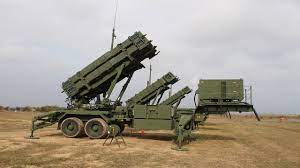Patriot Air Defence Missile System:

The Pentagon recently said that it will send additional Patriot air defence missile system battalions to the Middle East in response to recent attacks on U.S. troops in the region.
- The Patriot (MIM-104), which stands for Phased Array Tracking Radar for Intercept on Target, is the S. Army’s most advanced air defense system.
- It is an all-weather surface-to-air missile defense system to counter tactical ballistic missiles, cruise missiles, and advanced aircraft.
- It was developed by Raytheon, an American multinational aerospace and defense conglomerate.
- The system was first used in combat during the 1991 Gulf War, with batteries protecting Saudi Arabia, Kuwait, and Israel, and was later used during the U.S. invasion of Iraq in 2003.
- It is in service with the US and allied countries, including Germany, Greece, Israel, Japan, Kuwait, the Netherlands, Saudi Arabia, South Korea, Poland, Sweden, Qatar, the United Arab Emirates, Romania, Spain, and Taiwan.
- It is a mobile system that usually includes powerful radar, a control station, a power generator, launch stations, and other support vehicles.
- Depending on the version in use, the interceptor missiles can reach an altitude of more than 24 kilometres and hit targets up to 160 kilometres away.
- Its radar can track up to 50 targets and engage five of them at once.
- It is equipped with a track-via-missile (TVM) guidance system. Midcourse correction commands are transmitted to the guidance system from the mobile engagement control centre.
- A Patriot battery can need as many as 90 troops to operate and maintain it.




